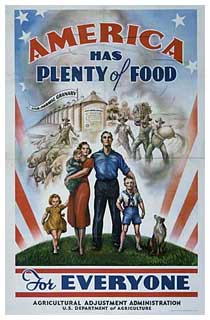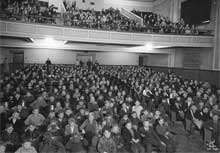Who is this "Greatest Generation"?
The Minnesotans who grew up during the Great Depression were members of a unique generation in American history. They were among the first comic book readers, the first regular movie-goers, the first devoted radio listeners, the first mass consumers, the first to place their trust in the federal government, and the first to endure the hardships of a decade-long economic depression. Many of them went on to do great things in war and peace. Many lived quiet lives of dignity and grace. And many continued to battle adversity throughout their adult lives. Their experiences during the Great Depression were instrumental in making them who they became.
Keep your sunny side up, up!
Hide the side that gets blue.
If you have nine sons in a row.
Baseball teams make money, you know!
Keep your funny side up, up!
Let your laughter come through, do!
Stand up on your legs;
Be like two fried eggs;
Keep your sunny side up.
For many Minnesotans who grew up during the Great Depression, the ability to dwell on the sunny side of life, even when conditions seemed darkest, was a talent that made daily existence just a little more bearable. But optimism did not come easily. The depression grabbed hold of Minnesota—and the rest of the country—during the earliest months of the 1930s, and did not let go for nearly a decade. The children who lived through those years never forgot what it was like. The experience shaped their lives. The joys and heartaches of growing up in Minnesota during the 1930s stayed with them over the decades as they fought a world war, built their careers, and raised families of their own.
Getting By
On its simplest level, the Great Depression was an economic crisis. Between 1929 and 1933, the average family in the United States saw its income drop by more than one third. The national jobless rate, which stood at about three percent in October of 1929, reached at least twenty-five percent less than four years later. The numbers in Minnesota were comparable, although residents in some parts of the state—the Iron Range, for example, where the unemployment rate hit seventy percent—suffered more than others. Children did not always understand the larger economic forces that were swirling around them, but they could tell something was wrong. Their fathers came home with news of pay cuts and layoffs. Their mothers struggled to make a few days' food last an entire week. Illnesses went untreated. Clothes wore out and were seldom replaced. Many kids scavenged for food. Others took low-paying jobs to help their families survive. Even those whose families weathered the crisis reasonably well felt less secure than they ever had before. All around them they saw evidence of an economy in shambles, and the adults they depended on were helpless to do anything about it.

Helping Hands
Before the 1930s, most Minnesotans had little direct contact with the federal government. About the only federal workers they ever ran into were employees for the U.S. Postal Service. But the Great Depression permanently changed the relationship between the American people and their government. In the weeks and months after he took the oath of office in 1933, President Franklin Roosevelt began mobilizing the federal bureaucracy to help Americans cope with what was turning out to be an agonizingly persistent economic calamity. He pushed through legislation creating an alphabet soup of new federal agencies including the Agricultural Adjustment Administration (AAA), the Federal Emergency Relief Administration (FERA), and the Public Works Administration (PWA). Later initiatives included the Works Progress Administration (WPA), the Rural Electrification Administration (REA), and Social Security. Together, Roosevelt"s initiatives formed the core of what became known as the "New Deal." For the first time, the federal government was assuming an active role in the lives of many, if not most, U.S. citizens.

Popular Culture
While all Americans who grew up during the 1930s experienced the Great Depression in their own, personal ways, they also shared a growing list of mutual interests with other members of their generation.
Radio may have done more than anything to make young Minnesotans feel connected to likeminded youngsters elsewhere in the United States. While sales of most consumer goods dropped after the stock market crash in 1929, radios continued to fly off the shelves. As the radio audience grew, broadcasters added new and better programming—including shows targeted directly at children. Programs like Jack Armstrong, The All American Boy, The Lone Ranger, and the Little Orphan Annie Show riveted young listeners. Sponsors, looking to develop a new generation of loyal customers, offered kids prizes in exchange for box tops and other proofs of purchase.
Other forms of entertainment reinforced the common national culture that developed as the depression slogged on. Children flocked to the movies when theater owners lowered admission prices in response to worsening economic conditions. Any kid with a dime to spare could spend an entire afternoon or evening watching the same films that other young Americans were watching—kid flicks like Shirley Temple"s Stand Up and Cheer, monster movies like Frankenstein and King Kong, and gangster dramas like Public Enemy and Scarface. Other youngsters spent their precious pennies on another new form of entertainment: comic books. In 1938, D.C. Comics published the first issue of Superman. In the years that followed, publishers introduced hundreds of other comic book superheroes. Kids were entranced. Many parents were appalled.

Investigate Further
Minnesota's Greatest Generation Articles
- Movies and the Movie-going Experience of the 1930's
- Growing Up in the Depression
- Country Kids
- Civilian Conservation Corps
Library Resource Topics
- Gangsters in St. Paul
- Prohibition and the Volstead Act
- Rondo Neighborhood & the Building of I-94
- 1934 Truckers' Strike (Minneapolis)
- WPA Art Project
Minnesota History Quarterly
- Union in the North Woods: The Timber Strikes of 1937
by Stacy Mitchell
Spring 1999 (Volume 56, number 5, pages 263-277) - The CCC Indian Division
by Calvin W. Gower
Spring 1972 (Volume 43, number 1, pages 3-13) - The Civilian Conservation Corps: A New Deal for Youth
by Frederick K. Johnson
Fall 1983 (Volume 48, number 7)
Collections


